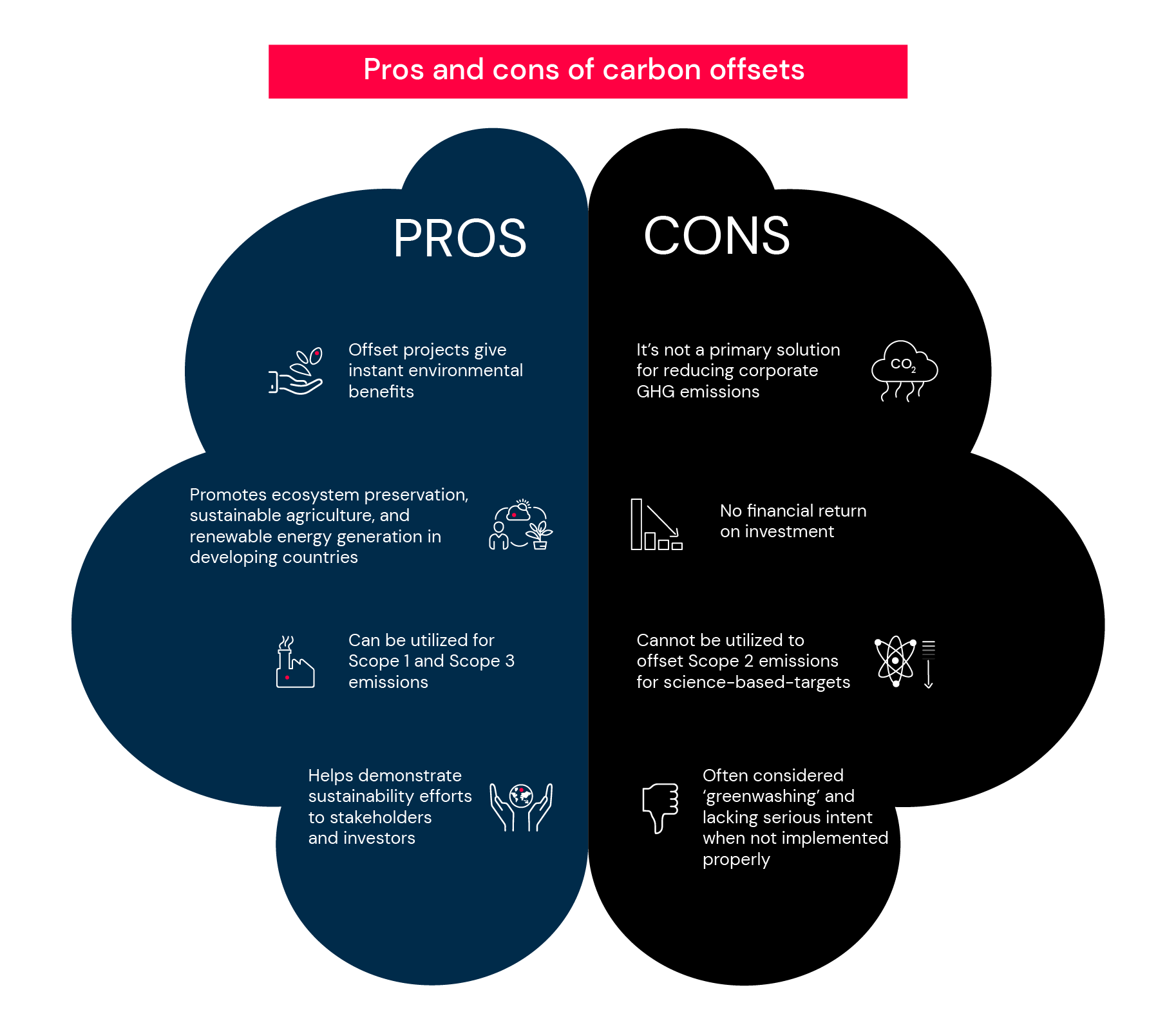For businesses looking at achieving net-zero goals, carbon offset is a boon. It provides them with an option to offset unavoidable emissions while staying on track with their goals to achieve net-zero status. Compared to carbon reduction strategies that eliminate internal emissions, carbon offsets work by funding Greenhouse Gases (GHG) reduction projects.
That said, like everything else in the world, opting for carbon offsets has its pros and cons. Let us take a deep dive into some of these down the section.
All you need to know about carbon offsets
For businesses looking at achieving net-zero goals, carbon offset is a boon. It provides them with an option to offset unavoidable emissions while staying on track with their goals to achieve net-zero status. Compared to carbon reduction strategies that eliminate internal emissions, carbon offsets work by funding Greenhouse Gases (GHG) reduction projects.
That said, like everything else in the world, opting for carbon offsets has its pros and cons. Let us take a deep dive into some of these down the section.
What is a carbon offset?
A carbon offset is a reduction or removal of emissions (carbon dioxide or other greenhouse gases) from the atmosphere and traded as part of a commercial scheme.
Typically, offsets are measured in tons of carbon dioxide – equivalent (CO2e). To obtain a carbon offset, one ton of carbon dioxide or its equivalent in other greenhouse gases must be reduced or removed.
Why carbon offset is important?
Carbon offsets let businesses reduce GHG emissions while increasing carbon storage to make up for unavoidable emissions from their operations. These offsets can be tailored to said company’s environmental and governance plan and help reduce their carbon footprint.
The pros and cons of carbon offsets
Carbon offsets play a crucial role in helping businesses achieve net-zero goals. To effectively implement offsets into a company’s decarbonization strategy, it is necessary to know its benefits and limitations. Hopefully, this information will help you select the most effective strategy when it comes to decarbonization.

What are the benefits of carbon offsets?
Offsetting can benefit enterprises not just by helping them reduce their carbon footprint, but also secure funding for environmental projects. Let’s elaborate on some of these benefits:
1. Reducing carbon footprint
Carbon offset allows businesses to minimize their carbon footprint while supporting relevant projects aimed at reducing carbon emissions. For instance, Alphabet, Google’s parent company, has been purchasing quality carbon offsets for a long time. Most recently, they successfully eliminated its entire lifetime carbon footprint solely with the help of carbon offsets.
2. Enforcing environmental policies
Environmental policies have become increasingly complex and demanding in response to environmental challenges across geographies. This is where opting for carbon offsets makes sense as it allows enterprises to stay compliant with different environmental policies, avoid penalties and comply with local standards at the same time.
3. Claiming carbon neutrality status simplified
Offsetting allows businesses to bestow a ‘carbon neutral’ status to certain aspects or projects of their enterprise. The ‘carbon neutral’ status helps enhance a company’s reputation that lets them attract new investors and conscious customers.
4. Providing resources for projects
Many initiatives are often overlooked due to lack of funds, but with offsetting, enterprises can choose relevant projects that help boost their net-zero initiatives. Once a project is successful, similar follow-up projects then attract more funding opportunities.
Limitations of carbon offsets
Carbon offsets may be an effective way to reduce carbon emissions, but they come with a series of challenges that enterprises should know about. We discuss some of these below:
1. Not the only option
Offsetting is a tool, not the ultimate answer for companies who want to reduce their carbon impact. Decarbonization is a lengthy process that requires businesses to alter their internal and external strategy to include more sustainable practices. Only after applying different methods – from switching to renewable or clean energy sources to implementing carbon accounting, should an enterprise focus on offsetting.
2. It is expensive
Cost is a key concern with carbon offsetting. It can range lower than $1 or over $50 per ton. The ROI on these investments, however, may not be concrete as they only mitigate CO2 emissions. That is why enterprises need to first focus on sustainability initiatives such as solar or wind installations, switching to LED lights, and explore energy saving alternatives for commuting to workplace. Why? Because these activities generate return-on-investment over time. Moreover, offsetting costs may get passed to the end consumer, who might switch to alternative products with lower prices and lower GHG intensities.
3. Setting targets
Another drawback with carbon offsets is that they can only be used to offset carbon emissions to meet Scope 2 emissions. SBTi for instance does not allow businesses to leverage offsets. It is because they are allowed to make operational changes only once for Scope 1 emissions. Businesses cannot use these offsets for internal strategies and are marketed for carbon-neutrality, but they must meet specifications set by SBTi targets.
4. Teeming with controversies
Several media reports suggest businesses polluting the environment and purchasing offsets rather than improving their efficiency. Enterprises can avoid this and protect their reputation by ensuring their shareholders view purchasing offsets as a tool to reduce emissions with operational changes, unavoidable emissions, implementing internal target setting strategies, and offsetting historical emissions.
Cost of carbon offsetting
Currently, the cost of carbon offsetting remains low due to a surplus of voluntary offset market credits over many years. On an average, the price stand at $3-5 per metric ton of CO2 but experts fear that these prices are far below the required level to unlock significant investment.
A research by Trove Research and University College London (UCL) states that the present surplus of carbon offset credits could be swiftly eroded with expected demand to increase fivefold or tenfold companies strive to meet their net-zero commitments. This means that enterprises need to plan for substantially higher carbon credit prices and make educated trade-offs between reducing emissions and buying credits.
Final thoughts
To summarize, carbon offsets are widely utilized for decarbonization given their benefits, narrative building, and unique use-cases. As carbon offsets provide direct finance to different projects, CFOs must ensure that their enterprise selects specific projects registered with trusted registries. Long-term initiatives based on offsets may be endangered by a fast-evolving regulatory climate.
Carbon offsets need to be viewed as one of the options from a larger toolbox for reducing greenhouse gas emissions. The primary tool or strategy however must focus on long-term emission reduction strategies. When combined with renewable energy certificates, power purchase agreements, and operational changes, it can be a powerful tool to reach carbon neutrality.
Other resources

Carbon accounting to reach net zero: Shuchi Nijhawan of Eka
A net-zero strategy starts with understanding, measuring, and monitoring carbon emissions.

How to build your strategy for carbon accounting and offsetting
Evolving regulatory environment is causing enterprises to double down on carbon accounting and offsetting initiatives.